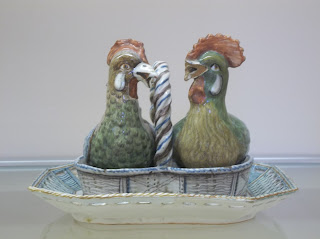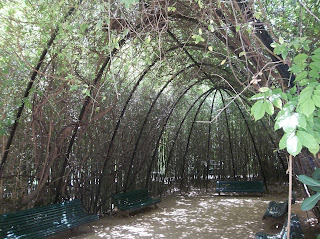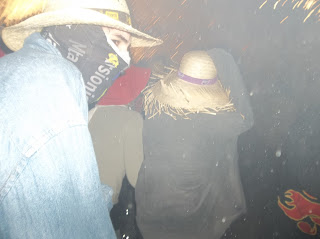The previous royal palace had burned down in 1875, so a bunch of monarchists raised serious cash and built Palau de Pedralbes. Of course, this gentrification of the area (pretty far outside the town center, especially back in 1919 when the idea was proposed) raised the value of the Guells' land by creating a new fabulous neighborhood for the rich and famous.
 This famous statue, Queen Isabella II Introducing Prince Alfonso XII is by Agapit Vallmitjana (try saying that five times fast) and sits just outside the entrance to the palace
This famous statue, Queen Isabella II Introducing Prince Alfonso XII is by Agapit Vallmitjana (try saying that five times fast) and sits just outside the entrance to the palaceThe palace was given new life in 1932 as the Museum of Decorative Arts, but it was closed during the Civil War and used as a residence for the president of the Spanish Republic until the end of the war. Beginning in 1939, the new Spanish dictator General Francisco Franco (dun dun dun) used it as his Barcelona residence. It was then used for important exhibitions starting in the 1960s and has housed both the Museum of Decorative Arts AND the Museum of Ceramics since the 1990s. Therefore, it was these two museums that I came to see.
I had been warned that these museums were only fascinating if you are utterly consumed by either ceramics or unlimited-budget interior design. While this is true, I still found it fun to poke around and admire all the pretty things. Plus, it was interesting to see the history of Spain reflected in the ceramics exhibit, since some of the pieces (like the one below) dated back to the tenth century.
The designs on later pieces reflected first Islamic and then Italian influences; as techniques improved, more colors and detail (as well as more adventurous shapes) appeared. It was like watching Spain hasten toward a modern world.
And then came the birth of the ceramic tile scenes that decorate the city and have become one of my favorite features of major buildings.
This one's a game: most of these depict careers but one seems to depict a highly random scene. Or a very strange career. Can you find it? (Answer at the bottom)
And I found a new Spanish fling (feelings not reciprocated. Alas for unrequited love and a very heartless love interest).
These I just thought were fun... they're for olive oil and vinegar.
The exhibit closed with a few modern pieces; these two made me laugh.
 "Deluxe money box: A money box for large projects that can only be filled with bills as it doesn't hold coins" (by Ana G. Capell)
"Deluxe money box: A money box for large projects that can only be filled with bills as it doesn't hold coins" (by Ana G. Capell) "Maiolica bottles: Traditional ornamental plate and jug motifs applied to soft drink bottles with the skill of the artisan masters whose brush strokes decorate mass-produced pieces with industrial shapes and connotations" (by Julio Badajoz)
"Maiolica bottles: Traditional ornamental plate and jug motifs applied to soft drink bottles with the skill of the artisan masters whose brush strokes decorate mass-produced pieces with industrial shapes and connotations" (by Julio Badajoz)Just a stroll across the palace and I was in the exhibit on Decorative Arts. I found this one slightly boring, since everything just seemed too fancy and ornate to be useful. This bed did confuse me a bit (and we thought water beds were impractical!):
But mostly, I enjoyed the Decorative Arts exhibit because it showed off the grandeur of the residence. Can you imagine living somewhere with walls and a ceiling painted in Sistine Chapel-esque splendor?
After touring the palace, I got a chance to see the gardens. You're first welcomed into this haven of cool, quiet greenery by Mediterrania, a female nude by Eulalia Fabregas de Sentmenat. She seems rather happy to be frolicking in the water, and in the heat of midday, everyone who walked by was pretty jealous (all fountains are marked as non-potable water and not for swimming. Phooey).

Mediterrania was joined by several sculptural friends. This piece, called Kolonihaven (Playhouse) by Enric Miralles, was roped off from public use (ironically).
Pshhh. That didn't stop the toddling kids that I saw from making use of it.Since this was a Guell project, Gaudi was obviously involved. He contributed two pieces; the first, called Pergola, seems to pay tribute to his love of nature in its simplicity. He provides a space to enter nature and appreciate it, while using the same curved arches that look like ribcages in the attics of the townhouses he designed for wealthy clients (i.e. Casa Batllo, Casa Mila).
Gaudi's other contribution was the Hercules Fountain (1884). Constructed early in his career, Gaudi renders the hero in a more classic style.
Just up the street from this park was another one that I have wanted to see for quite some time. Parc Cervantes, a triangular plot of land along the end of Diagonal (the street that cuts through the city as an equal-opportunity grid disrupter). While it has the typical winding paths among trees and offers serenity, it also offers an incredibly display of roses. Native Catalunyan roses brush thorns with breeds from around the world. The rose gardens of Parc Cervantes have even been internationally recognized for excellence.
After a long week, I was excited to literally stop and smell the roses. All several thousands of them. The feeling one gets while walking through this part of the park is perfectly depicted by Serenittat, a female nude by Eulalia Fabregas de Sentmenat (same sculptor as the other park).
And now follow a huge amount of pictures of really gorgeous flowers. I swear, I spared you from seeing about 100 more pictures of beautiful blooms.
And that, my friends, is how I spent the afternoon with Ginger Syllabub, Long John Silver, Constance Spry, Coral Dawn, Mermaid, and Aloha.
After so much green, it was time for some blue (and some more green). I headed back downtown to Parc de Ciutadella (Citadel Park)
to meet up with two fellow Yalies. Kaylee and Charlie, who just graduated, are on Day 39 of an epic Eurotrip designed to test their perseverance in the face of Too Much Awesomeness and excessive amounts of time in each other's company. They are doing an admirable job, having conquered 11 countries so far. Even better? They were game to join me on another adventure: paddle boating.
While some might hem and haw about how you can't really have an adventure on a tiny lake in the middle of a park, we beg to differ. With the help of our human motor Charlie
and the incredible chlidishness of all three fearless sailors, we managed to colonize an island (dubbed Baller; note that in Castellano this is pronounced Bah-yehr. Also note our beautiful flag) and defend it from ducks
as well as get stranded on underwater rocks, peg unsuspecting imaginary enemies with seedpods from trees mysteriously growing in the middle of the lake, and nearly paddle through a waterfall beneath a bridge. All in a day's work for intrepid explorers.
Spotted: Franklin and Marshall gear.
If you haven't heard about this stunning new trend all over Europe, two hip young designers bought a Franklin and Marshall t-shirt at a flea market a few years ago and turned it into one of the biggest fads this side of the pond. Read more about it here.
Answer from trivia above: bottom row, second from the right. This man appears as a torso rising out of a sea creature. This isn't what I do at work every day... maybe this career died out in the 19th century?


































































